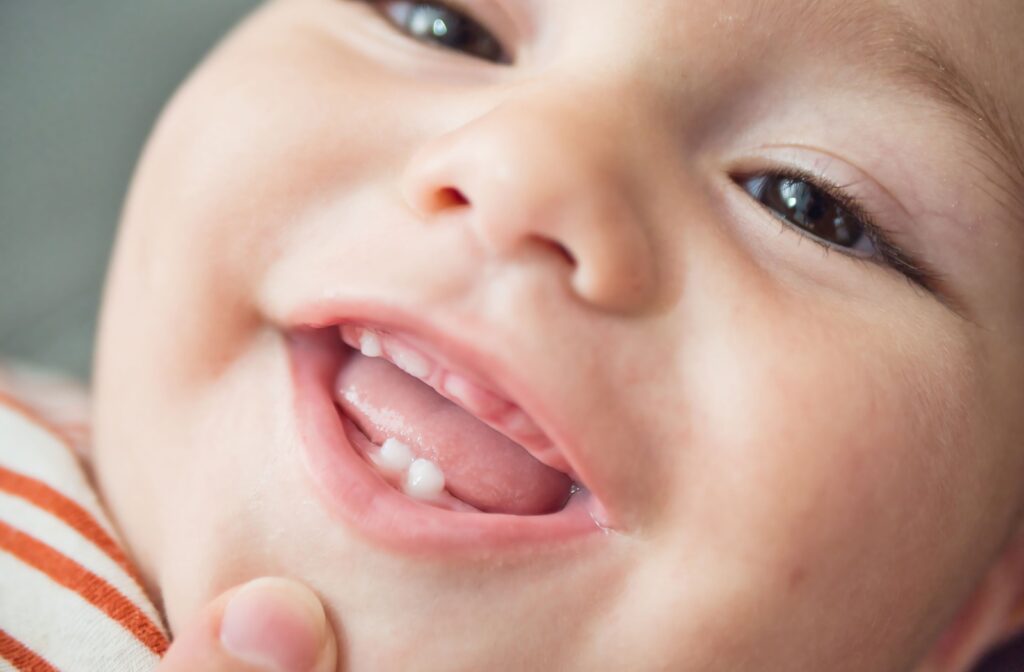You might notice your child’s first few teeth arrive at odd angles, which is a normal part of the teething process. It’s natural to feel a little concerned when you see crooked baby teeth. Many parents in London have the same questions you do, and you’re in the right place for answers.
This guide can help you understand why this happens and what it means for your child’s dental health, explaining why specialized pediatric care is so valuable. The good news is that crooked baby teeth are very common and often not a sign of future problems. We’ll explore the typical causes and how you can support their smile from the very beginning.
Common Reasons for Crooked Baby Teeth
It’s common for baby teeth to erupt at unusual angles or look slightly crowded. Several factors can influence this, including:
Not Enough (or Too Much) Space
Baby teeth rely on a balance between tooth size and jaw size. Sometimes, the jaw is a little smaller when the first teeth come in, which can make them look crowded or angled. But the opposite can also happen — a larger jaw with small teeth can leave extra space, causing teeth to “float” or flare outward until more teeth arrive and fill the gap.
As your child grows, both the jaw and teeth continue developing, and spacing often changes naturally over time. A pediatric dentist can monitor this growth to make sure everything is progressing as expected.
Genetics & Family Traits
Tooth shape, size, and jaw structure are largely inherited. If crooked teeth run in the family, your child may have a similar pattern.
Childhood Habits
Extended thumb-sucking or pacifier habits can gently shift baby teeth. Over time, this can affect how they come in, but early guidance can help reduce long-term effects.
What Crooked Baby Teeth Mean for Permanent Teeth
Parents often wonder if crooked baby teeth mean crooked adult teeth later on. This isn’t always the case, as your child’s mouth is still growing and changing a lot. The alignment of baby teeth can offer clues, but it’s not a prediction.
Baby teeth act as important placeholders for the permanent teeth that will follow. Their position can give a pediatric dentist an idea of the space available. Early observation helps a dental professional monitor jaw growth and spacing for the future.
This allows them to note any potential alignment issues for permanent teeth down the road. It’s about proactive care and observation—not a cause for immediate worry. Think of it as mapping out the road ahead for your child’s smile.

How a Pediatric Dentist in London Can Help
Choosing a pediatric dentist means working with someone who specializes in growing smiles. Here’s how we support your child’s dental journey:
Monitor Growth & Development
During a check-up, your pediatric dentist assesses your child’s teeth, gums, and jaw. They track how your child’s smile is developing from one visit to the next. This helps them spot any patterns or potential issues early on.
Offer Guidance on Habits
If habits like thumb-sucking are a concern, your dentist can offer practical and empathetic advice. They can provide gentle and supportive strategies to help your child move on from the habit. This advice is always tailored to your child’s age and personality.
Create a Positive Dental Experience
Bringing your child to a pediatric dentist from a young age helps them feel comfortable in a dental setting. It establishes a foundation for a lifetime of good oral health. Our approach to gentle children’s dentistry ensures these early visits are simple and focused on prevention.
Support Your Child’s Dental Health at Home
You play a key role in keeping those little teeth healthy and strong. Here are some ways to help from day one:
- Clean Their Teeth Daily: As soon as the first tooth appears, gently clean it with a soft cloth or a small, soft-bristled toothbrush. You can use a tiny smear of fluoride toothpaste—about the size of a grain of rice.
- Encourage Healthy Foods: A balanced diet low in sugary snacks and drinks helps protect their teeth from cavities. Offer water instead of juice, and focus on tooth-friendly snacks like cheese, yogurt, and veggies.
- Observe Their Mouth: Take a peek inside their mouth regularly. You’ll be the first to notice new teeth or any changes. You can make it fun by playing “count the teeth” or singing a song while you look.
When to Book a Dental Appointment
Knowing the right time for a first dental visit can feel tricky. The general guidance suggests a visit around their first birthday or when the first tooth appears. This initial appointment is more of a friendly introduction than a complex procedure.
This first visit gives you a chance to ask all your questions and gives us a chance to get to know your child. A positive start can help build a happy relationship with dental care from the beginning. It’s a great step for any parent with a little one.
If you’re looking for a pediatric dentist in London, scheduling a visit is a wonderful way to get started. At London Little Bites Dentistry, we’re here to be your partner in your child’s oral health journey. Contact us today to set up a happy first visit for your little one.


